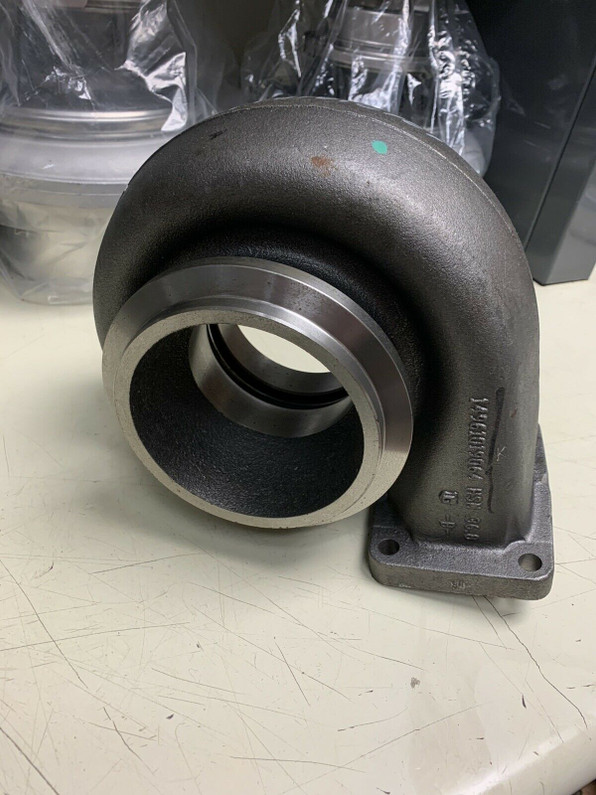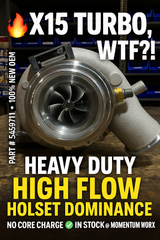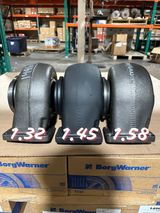Turbine Housing Explained | Which A/R works best?
A/R stands for Area over Radius. Area is the size of the housing inlet and radius is the the diameter of the housing. Before every keyboard warrior jumps down my throat...this is just a basic explanation for the sake of a general overview -we don't need to get lost in the weeds, we'll leave that for scientist and engineers :)

The larger the AR number, the larger the housing is. Larger housings support higher horsepower levels, but take more exhaust gasses to turn the wheel and make boost. Smaller housings spool up faster, but become a restriction and generate back pressure for the engine because the exhaust gas has no where to go. This is why it is important to find a housing that works best for your specific application.
A parallel discussion here is whether or not a wastegated or non-wastegated housing is best. A wastegated housing has a small port hole in it with a door that is controlled by an actuator. The actuator can be air powered or electronically controlled. When the door/gate is commanded to open, it allows exhaust gas to bypass the turbine wheel and be "wasted" into the exhaust system. This has 2 main functionalities: 1) It keeps the turbo from being over sped and failing, and 2) it prevents excessive back pressure because it gives the exhaust gas a place to bleed off.
A wastegated housing allows for fast spool up when the gate is closed, and minimal backpressure when the turbo is at operating speed and the gate is open. The draw back here is that you can only achieve a certain level of boost because the wastegate opens and prevents the turbo from being spooled up further. An appropriately sized non wastegated housing will allow you to achieve higher peak boost numbers while maintaining adequate spool up.

Back to sizing....
While the above information applies to all turbochargers, we are going to now focus on our own expertise, which is large diesel displacement turbocharger systems.
One of the most popular upgrades on Cat 3406/C15 engines is a 78/1.32 turbo. This is an S410SX turbo with a 78MM compressor wheel inducer and a 1.32AR non wastegated exhaust housing. While this turbo is ideal for a 550-600HP truck, you may want to run it on a larger file and add more fuel; this is where a larger exhaust housing comes into play. By adding a 1.45 A/R housing, you are effectively slowing the turbo down and increasing the spool up time, but the additional size will support higher horsepower levels because the turbo can now make more boost and have less back pressure at operating speed.
If you add a larger turbo and experience high EGTs, this can often be caused by a housing that is too large for your setup. High EGTs occur when there is lots of fuel and not enough air. This is why EGT's will cool off as the boost goes up. Some times EGT will skyrock too fast and the turbo cannot come in fast enough to compensate. In this scenario, a smaller housing can spool up faster to supply the correct amount of air to the combustion chamber to prevent excessive EGTs.
Ideal turbo setups will always have some variance, what works in one situation might not work in another. This is largely because of different tunes, driving styles, and support modifications (Cam, injectors, displacement/compression ratio, etc)
Recent Posts
-
Inside the Cummins X15 EPA21 HE400 Turbocharger: What Changed and Why It Matters
Inside the Cummins X15 EPA21 HE400 Turbocharger: What Changed and Why It Matters While we at Momentu …4th Aug 2025 -
The History of CAT 3406E Engines: A Milestone in Diesel Power
The CAT 3406E engine is one of the most iconic diesel engines ever produced by Caterpillar Inc., kno …26th Jun 2025 -
1.32 A/R, 1.45 A/R, or 1.58 A/R - Which one do you have on YOUR Turbo?
The BorgWarner S400 and S410SX turbos are SUPER popular for CAT, Cummins, and Detroit trucks. While …11th Jul 2024




